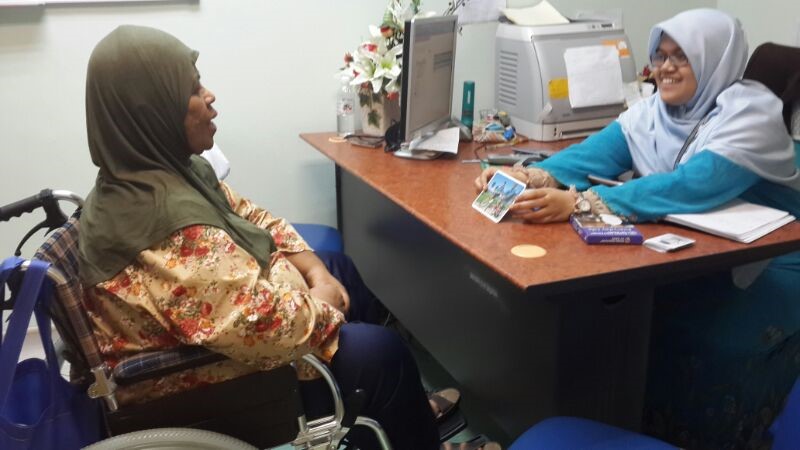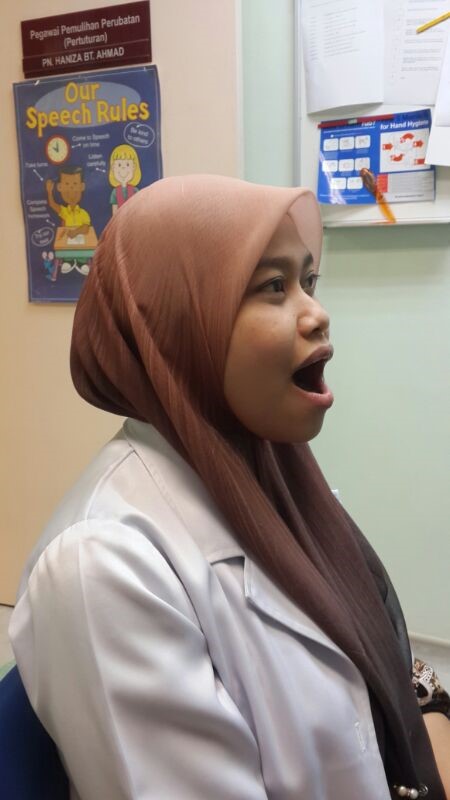Do pronunciation or articulation difficulties exist among senior citizens? This question may come across your mind when you read the title of this article. In later years, any individual may experience articulation difficulties when the movement or functions of their articulators are affected. A possible cause may be due to health issues such as stroke, brain tumour or brain damage.
Some of us may meet or have experience with an individual with stroke who has less intelligible speech. This individual may suffer from dysarthria and/or apraxia.

Dysarthria
Dysarthria affects the functions of nerves, brain or muscle involved. Muscles may become weak or paralysed. The deterioration may be slow or sudden.
Symptoms of Dysarthria :
- Unclear speech
- Soft voice (whispering) or too loud of a voice
- Fast speech rate with poor speech clarity
- Difficulty in pronunciation
- Difficulty in lips, mouth and tongue movement.
- Limited jaw movement
Dysarthria may indicate more serious health problems such as:
- Parkinson’s disease
- Multiple Sclerosis
- Muscular dysthrophy
- Amyotropic lateral sclerosis (ALS, or Lou Gehrig Disease)
At this stage, further assessment needs to be done by a medical officer to identify main problems that can cause dysarthria
Speech Language Therapy
Speech Language Therapists will help individuals with dysarthria to have optimal speech ability. The minimum target would be getting his speech understood by family members and close friends.

Speech Therapy Goals
- Strengthening muscles via exercises
- Improving pronunciation
- Improving respiration skill
- Altering speech rate
- Training family members to communicate effectively with individual with Dysarthria

For severe cases, a Speech Language Therapist will suggest other methods to communicate known as Augmentative and Alternative Communication (AAC). This method will be used when verbal communication is not or less effective.
Tips for Individuals with Dysarthria to Communicate:
- Speak clearly and slowly. The listener will understand your speech if you take more time to speak clearly.
- Use direct and short phrases to transfer messages to listeners. You will feel more confident in transferring the message. Short and direct phrases also benefit in reducing the speech error. For examples: “”I’m hungry. Buy me KFC’s chicken. Drumstic.”
- Get feedback from listeners whether they can understand your speech. For example: “Do you understand?”
- Use body gestures such as hand movements or facial expressions to increase listeners’ understanding.
- Prepare a note book or hand phone if listeners have difficulty to understand your speech. Write or type to send the message. The important thing is listener can received your message.
Tips for Family Members and Friends
- Give more time for patient to response. Appropriate time period given helps patient to construct his sentences and improve his pronunciation.
- Avoid cutting off or correcting patient’s sentences. Too frequent cutting off and correcting patient’s sentences will make them frustrated and reduced his self-esteem.
- Have a conversation in a quiet environment helps you to focus on his sentences and reduced distraction. As a sequence, you will understand him better.
- When a patient is talking, avoid talking at the same time.
- Attend to and focus on the patient’s speech
- Clarify the information you receive from the patient
For example, ” Do you want to eat fried rice or chicken rice?” - Prepare pen and paper to help patient to communicate.
- Communicate as usual. Usually a dysarthric patient does not have problem to understand others’ speech. Avoid excessive facial expression and body gesture usage.
References
- Dysarthria; retrieved 1/9/2015 from http://www.asha.org/public/speech/disorders/dysarthria/
- Dysarthria; retrived 1/9/2015 from http://wwww.mayoclinic.org
- Dysarthria: retrieved 1/9/2015 from https://www.nlm.nih.gov
- Neurogenic Disorders Prevalence and characteristic of speech Disorder and How They Can Affect Communication; retrieved 30/8/2015 from https://constanttherapy.com/blog/
| Last Reviewed | : | 28 August 2020 |
| Writer / Translator | : | Nurhayati bt. Mohd Mossadeq |
| Accreditor | : | Noormala bt. Anuar Ali |
| Reviewer | : | Nadwah bt. Onwi |







